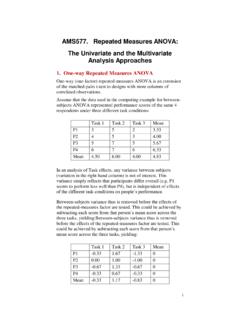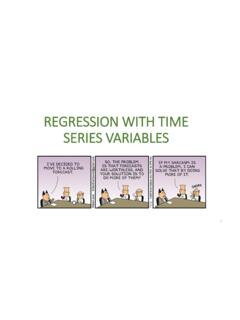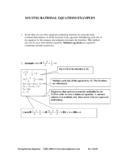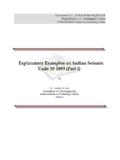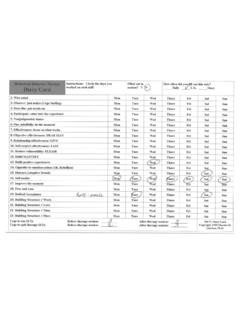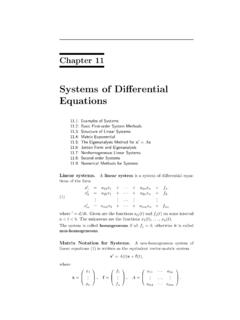Transcription of Examples: Joint Densities and Joint Mass Functions
1 AMS 311 Joe MitchellExamples: Joint Densities and Joint mass FunctionsExample 1:XandYare jointly continuous with Joint pdff(x, y) = cx2+xy3if 0 x 1, 0 y 20,otherwise.(a). Findc. (b). FindP(X+Y 1). (c). Find marginal pdf s ofXand ofY. (d). AreXandYindependent (justify!). (e). FindE(eXcosY). (f). Findcov(X, Y).We start (as always!) by drawing the support set. (See below, left.)21211y=1 xxyxysupport setBlue: subsetof support setwith y>1 x(a). We findcby setting1 =Z Z f(x, y)dydx=Z10Z20(cx2+xy3)dydx=2c3+13,soc= 1.(b). Draw a picture of the support set (a 1-by-2 rectangle), andintersect it with the set{(x, y) :x+y 1}, which is the region above the liney= 1 x.
2 See figure above, compute the probability, we double integrate the Joint density over this subset of thesupport set:P(X+Y 1) =Z10Z21 x(x2+xy3)dydx=6572(c). We compute the marginal pdfs:fX(x) =Z f(x, y)dy= R20(x2+xy3)dy= 2x2+2x3if 0 x 10otherwisefY(y) =Z f(x, y)dx= R10(x2+xy3)dx=13+y6if 0 y 20otherwise1(d). NO,XandYare NOT independent. The support set is a rectangle, so we need tocheck if it is true thatf(x, y) =fX(x)fY(y), for all (x, y). We easily find counterexamples:f( , )6=fX( )fY( ).(e).E(eXcosY) =Z10Z20(excosy)(x2+xy3)dydx(f).cov(X, Y) =E(XY) E(X)E(Y)=Z10Z20xy(x2+xy3)dydx Z10Z20x(x2+xy3)dydx Z10Z20y(x2+xy3)dydx example 2:XandYare jointly continuous with Joint pdff(x, y) = cxyif0 x,0 y,x+y 10,otherwise.
3 (a). Findc. (b). FindP(Y > X). (c). Find marginal pdf s ofXand ofY. (d). AreXandYindependent (justify!).We start (as always!) by drawing the support set. (See below, left.)yy1y=x11xx1y=1 xof support setwith y>xBlue: subsetsupport (a). We findcby setting1 =Z Z f(x, y)dydx=Z10Z1 x0cxydydx=c24,soc= 24.(b). Draw a picture of the support set (a triangle), and intersect it with the set{(x, y) :y x}, which is the region above the liney=x; this yields a triangle whose leftmostx-value is 0 and whose rightmostx-value is 1/2 (which is only seen by drawing the figure!).See figure above, right.
4 To compute the probability, we double integrate the Joint densityover this subset of the support set:P(Y X) =Z1/20Z1 xx24xydydx2(c). We compute the marginal pdfs:fX(x) =Z f(x, y)dy= R1 x024xydy= 12x(1 x)2if 0 x 10otherwisefY(y) =Z f(x, y)dx= R1 y024xydx= 12y(1 y)2if 0 y 10otherwise(d). NO,XandYare NOT independent. The support set is not a rectangle or generalizedrectangle, so we know we can find points (x, y) where it fails to be true thatf(x, y) =fX(x)fY(y). In particular,f( , ) = 06=fX( )fY( )> 3:XandYare jointly continuous with Joint pdff(x, y) = cxyif0 x 1,0 y 10,otherwise.(a).
5 Findc. (b). FindP(|Y 2X| ). (c). Find marginal pdf s ofXand ofY. (d).AreXandYindependent (justify!).We start (as always!) by drawing the support set, which is just a unit square in this case.(See below, left.)111xx1y=2x + support setwith .1<y 2x<.1 Blue: subset(a). We findcby setting1 =Z Z f(x, y)dydx=Z10Z10cxydydx=c4,soc= 4.(b). Draw a picture of the support set (unit square), and intersect it with the set{(x, y) :|y 2x| }={(x, y) : y 2x }={(x, y) : 2x y 2x+ },which is the region above the liney= 2x and below the liney= 2x+ See figureabove, left. (You will not be able to figure out the limits of integration without it!)
6 Tocompute the probability, we double integrate the Joint density over this subset of the supportset:P(|Y 2X| ) = (y+ )/204xydxdy+ (y+ )/2(y )/24xydxdy3(c). We compute the marginal pdfs:fX(x) =Z f(x, y)dy= R104xydy= 2xif 0 x 10otherwisefY(y) =Z f(x, y)dx= R104xydx= 2yif 0 y 10otherwise(d). YES,XandYare independent, sincefX(x)fY(y) = 2x 2y= 4xyif 0 x 1 and 0 y 10otherwiseis exactly the same asf(x, y), the Joint density, for 4:XandYare independent continuous random variables, each with pdfg(w) = 2wif0 w 10,otherwise.(a). FindP(X+Y 1). (b). Find the cdf and pdf ofZ=X+ independent, we know thatf(x, y) =fX(x)fY(y) = 2x 2yif 0 x 1 and 0 y 10otherwiseWe start (as always!)
7 By drawing the support set, which is a unit square in this case.(See below, left.)4xy=1 x1y11x1y11x1y1y=z xyxz= z= xof support setwith x+y<1 Blue: subsetsupport setof support setwith x+y< : subsetof support setwith x+y< : subsetCase: 1<z<2 Case: 0<z<1(a). Draw a picture of the support set (unit square), and intersect it with the set{(x, y) :x+y 1}, which is the region below the liney= 1 x. See figure above, right. To computethe probability, we double integrate the Joint density over this subset of the support set:P(X+Y 1) =Z10Z1 x04xydydx=16(b). Refer to the figure (lower left and lower right).
8 To compute the cdf ofZ=X+Y,we use the definition of cdf, evaluating each case by double integrating the Joint densityover the subset of the support set corresponding to{(x, y) :x+y z}, for different casesdepending on the value ofz:FZ(z) =P(Z z) =P(X+Y z) =P(Y X+z)= 0ifz 0Rz0Rz x04xydydxif 0 z 1R1 z0R104xydydx+R11 zRz x04xydydxif 1 z 21ifz 25 example 5:XandYare jointly continuous with Joint pdff(x, y) =(e (x+y)if0 x,0 y0, Find the pdf first thing we do is draw a picture of the support set (which in this case is the firstquadrant); see below, (1/z)xsupport setof support setwith (x/y)<z, for z>0 Blue: subsetTo find the density,fZ(z), we start, as always, by finding the cdf,FZ(z) =P(Z z),and then differentiating:fZ(z) =F Z(z).)
9 Thus, using the definition, and a picture of thesupport set, we start by handling the cases,FZ(z) =P(Z z) =P(X/Y z)= 0ifz <0P(Y (1/z)X) ifz >0,where we have used the fact thatXandYare both nonnegative (with probability 1), somultiplying both sides of the inequality byYdoes not flip the inequality; note, however,that when we divide both sides byz, to obtainY (1/z)X, we were making the assumptionthatz >0 (otherwise the inequality would flip).Now, we consider the picture of the support set, together with thehalfplane specifiedbyy (1/z)x; see the figure above, right. We double integrate the Joint density over theportion of the support set wherey (1/z)x, obtainingFZ(z) =P(Z z) =P(X/Y z)= 0ifz <0P(Y (1/z)X) ifz >0,=(0ifz <0R 0R (1/z)xe (x+y)dydx=zz+1ifz > , to get the pdf, we take the derivative:fZ(z) =(0ifz <0(z+1) 1 z 1(z+1)2=1(z+1)2ifz >06 example 6:XandYare independent, each with an exponential( ) distribution.))
10 Findthe density ofZ=X+Yand ofW=Y independent, we know thatf(x, y) =fX(x)fY(y), giving usf(x, y) = e x e yifx, y first thing we do is draw a picture of the support set: the first quadrant.(a). To find the density,fZ(z), we start, as always, by finding the cdf,FZ(z) =P(Z z),and then differentiating:fZ(z) =F Z(z). Thus, using the definition, and a picture of thesupport set together with the halfplaney x+z, we getFZ(z) =P(Z z) =P(X+Y z) =P(Y X+z)= 0ifz <0Rz0Rz x0 e x e ydydx= 1 e z ze zifz 0 This gives the pdf,fZ(z) = 0ifz <0 2ze zifz 0,which is the pdf of a Gamma(2, ). Thus,Zis Gamma(2, ) random variable.
